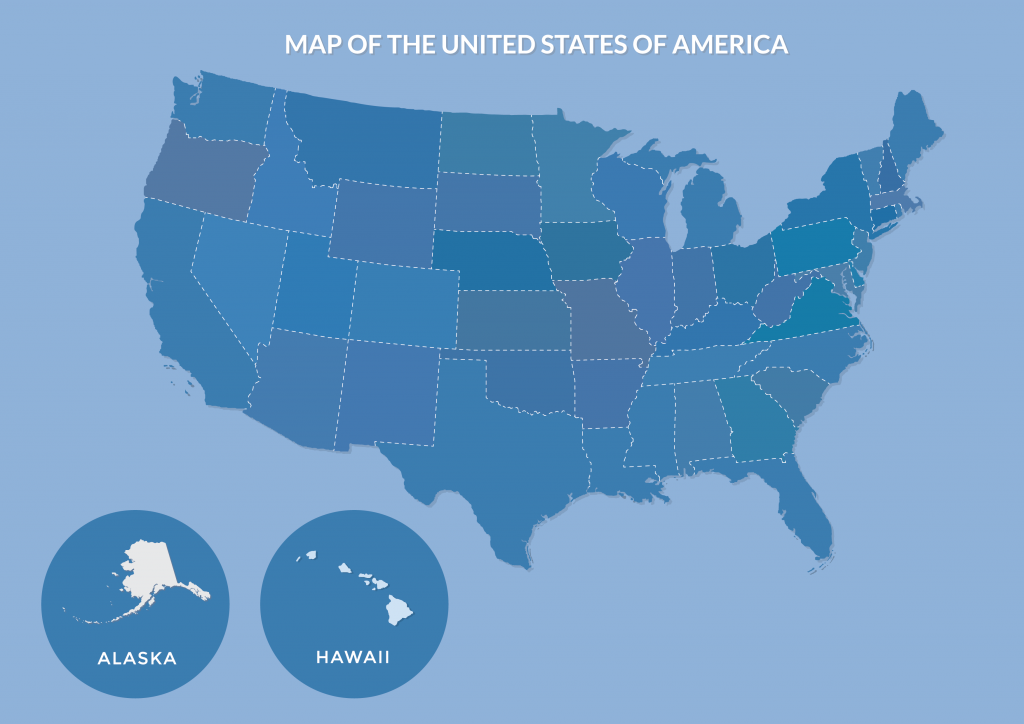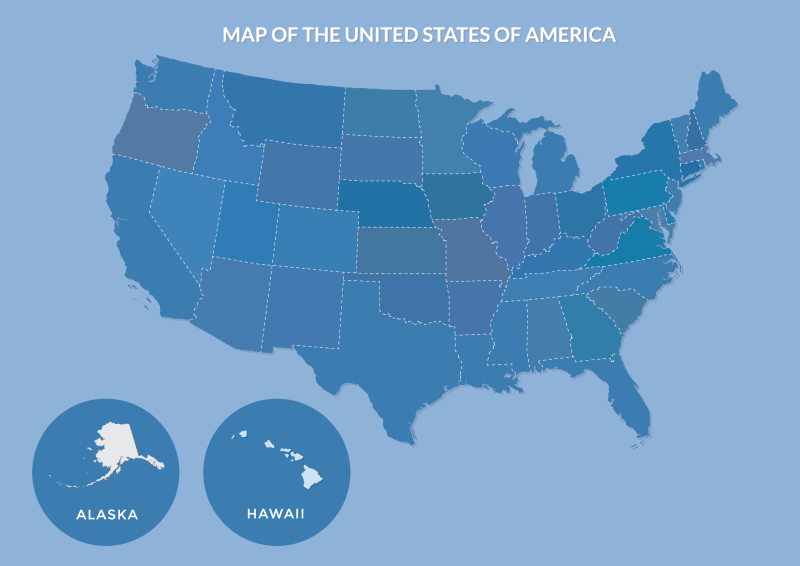
Highest Demand For Nurses by State
The highest demand areas for the nursing shortage by state, are the ten areas of the country with the biggest deficit. Nursing shortages occur when there are not enough nurses to meet the demands of the health care system.
What is causing the current nursing shortage? There is not an easy answer and a number of factors contribute to the problem. They include an aging population, an increase in the number of people requiring healthcare services, and an insufficient number of qualified nursing professionals entering the workforce. The shortage can also be attributed to a lack of available educational and training opportunities and an increase in the number of nurses leaving the profession from nurse burnout.
Which States Have the Greatest Nursing Shortage?
Much has been made of the current and future shortage of qualified, experienced nurses in the healthcare system. All over the US, states are expecting the next decade to bring a mass wave of retirements as Baby Boomers and older Gen-X nurses retire. Similarly, the supply of trained professionals coming out of nursing schools is often barely adequate to keep up with the current patient-to-nurse ratio of an aging and growing population. In some states the situation is dire and nurse burnout is real.
Behind Our Numbers
The stats TopRNtoBSN used to determine the states with the greatest need for nurses come from the US Bureau of Labor Statistics (US BLS RNs) and the US Census Bureau 2022 population estimate data (US Census). We compared the number of employed RNs in each state to the total population of each state. For each state, editors have listed the actual number of nurses per one thousand of the population.
There are more complicated ways to evaluate this problem. However, the data sources vary greatly from state to state. And factors that contribute to the problem are different from location to location. So we opted to use two national data sources to give you a snapshot of where registered nurse RN employment stands in each state based on its population.
National Nursing Workforce
The United States has a total population of 331,449,281 and employs 3,047,550 RNs. So the number of nurses per 1,000 people nationwide is 9.22. The national nursing workforce rate falls between Alaska and Arkansas.
| Location | Employed RNs | Population | Nurses Per 1,000 |
|---|---|---|---|
| United States | 3,047,550 | 331,449,281 | 9.22 |
1. Utah
- Employed Registered Nurses: 22,830 (BLS May 2022)
- State Population: 3,380,800 (US Census 2022 estimates)
- Nurses Per 1,000 Population: 6.75
2. Idaho
- Employed Registered Nurses: 13,608 (BLS May 2022)
- State Population: 1,939,033 (US Census 2022 estimates)
- Nurses Per 1,000 Population: 7.06
3. New Mexico
- Employed Registered Nurses: 15,910 (BLS May 2022)
- State Population: 2,113,344 (US Census 2022 estimates)
- Nurses Per 1,000 Population: 7.53
4. Oklahoma
- Employed Registered Nurses: 23,970 (BLS May 2022)
- State Population: 4,019,800 (US Census 2022 estimates)
- Nurses Per 1,000 Population: 7.54
5. Nevada
- Employed Registered Nurses: 23,970 (BLS May 2022)
- State Population: 3,177,772 (US Census 2022 estimates)
- Nurses Per 1,000 Population: 7.54
6. Georgia
- Employed Registered Nurses: 82,970 (BLS May 2022)
- State Population: 10,912,876 (US Census 2022 estimates)
- Nurses Per 1,000 Population: 7.60
7. Arizona
- Employed Registered Nurses: 56,040 (BLS May 2022)
- State Population: 7,359,197 (US Census 2022 estimates)
- Nurses Per 1,000 Population: 7.61
8. Texas
- Employed Registered Nurses: 231,060 (BLS May 2022)
- State Population: 30,029,572 (US Census 2022 estimates)
- Nurses Per 1,000 Population: 7.69
9. Virginia
- Employed Registered Nurses: 69,510 (BLS May 2022)
- State Population: 8,683,619 (US Census 2022 estimates)
- Nurses Per 1,000 Population: 8.00
10. Maryland
- Employed Registered Nurses: 49,790 (BLS May 2022)
- State Population: 6,164,660 (US Census 2022 estimates)
- Nurses Per 1,000 Population: 8.08

How Do Experts Define the Nursing Shortage?
One of the leading concerns in the healthcare industry is the current nurse shortage in at least twenty percent of US states. According to the Department of Health and Human Services, the ongoing nursing shortage is initially defined based on the supply of nursing currently registered in each state, and the growing demand for them based on the jobs available and the population of that state. They also take into consideration nursing shortage statistics with the current number of students enrolled in nursing schools for that state, determining what that gap is between the number of potential graduates and what jobs are available.
The Bureau of Labor Statistics (BLS) expects the Registered Nursing (RN) workforce to grow by 6% over the next ten years. This change from 3.1 million to 3.3 million means an overall increase of 195,400 nurses by 2030. Additionally, the BLS projects 203,200 job openings for RNs each year over the decade.
State RN Shortage by Population
| State | 2022 US Census Pop Est | Employed RNs BLS May 2022 | RNs per 1,000 |
|---|---|---|---|
| Utah | 3,380,800 | 22,830 | 6.75 |
| Idaho | 1,939,033 | 13,680 | 7.06 |
| New Mexico | 2,113,344 | 15,910 | 7.53 |
| Oklahoma | 4,019,800 | 30,320 | 7.54 |
| Nevada | 3,177,772 | 23,970 | 7.54 |
| Georgia | 10,912,876 | 82,970 | 7.60 |
| Arizona | 7,359,197 | 56,040 | 7.61 |
| Texas | 30,029,572 | 231,060 | 7.69 |
| Virginia | 8,683,619 | 69,510 | 8.00 |
| Maryland | 6,164,660 | 49,790 | 8.08 |
| Hawaii | 1,440,196 | 11,800 | 8.19 |
| South Carolina | 5,282,634 | 44,030 | 8.33 |
| Washington | 7,785,786 | 64,920 | 8.34 |
| California | 39,029,342 | 325,620 | 8.34 |
| New Jersey | 9,261,699 | 78,340 | 8.46 |
| Tennessee | 7,051,339 | 60,840 | 8.63 |
| Wyoming | 581,381 | 5,070 | 8.72 |
| Oregon | 4,240,137 | 37,400 | 8.82 |
| Florida | 22,244,823 | 197,630 | 8.88 |
| Montana | 1,122,867 | 10,020 | 8.92 |
| Colorado | 5,839,926 | 52,390 | 8.97 |
| Alaska | 733,583 | 6,730 | 9.17 |
| United States | 333,287,557 | 3,072,700 | 9.22 |
| Arkansas | 3,045,637 | 28,490 | 9.35 |
| Connecticut | 3,626,205 | 34,290 | 9.46 |
| Louisiana | 4,590,241 | 43,790 | 9.54 |
| New York | 19,677,151 | 190,470 | 9.68 |
| New Hampshire | 1,395,231 | 13,510 | 9.68 |
| Alabama | 5,074,296 | 49,370 | 9.73 |
| North Carolina | 10,698,973 | 104,300 | 9.75 |
| Indiana | 6,833,037 | 67,350 | 9.86 |
| Kentucky | 4,512,310 | 44,970 | 9.97 |
| Mississippi | 2,940,057 | 29,370 | 9.99 |
| Nebraska | 1,967,923 | 19,870 | 10.10 |
| Michigan | 10,034,113 | 101,470 | 10.11 |
| Rhode Island | 1,093,734 | 11,190 | 10.23 |
| Illinois | 12,582,032 | 129,390 | 10.28 |
| Wisconsin | 5,892,539 | 61,100 | 10.37 |
| Kansas | 2,937,150 | 30,520 | 10.39 |
| Maine | 1,385,340 | 14,610 | 10.55 |
| Pennsylvania | 12,972,008 | 137,970 | 10.64 |
| Iowa | 3,200,517 | 34,050 | 10.64 |
| Vermont | 647,064 | 6,930 | 10.71 |
| Ohio | 11,756,058 | 130,370 | 11.09 |
| Minnesota | 5,717,184 | 63,800 | 11.16 |
| Delaware | 1,018,396 | 11,490 | 11.28 |
| Missouri | 6,177,957 | 70,440 | 11.40 |
| West Virginia | 1,775,156 | 21,110 | 11.89 |
| Massachusetts | 6,981,974 | 94,100 | 13.48 |
| North Dakota | 779,261 | 11,300 | 14.50 |
| South Dakota | 909,824 | 14,360 | 15.78 |
| District of Columbia | 671,803 | 11,820 | 17.59 |
States With the Lowest Local Concentrations of Nurse Employment
A Location Quotient (LQ) is a measure of a region’s industrial specialization relative to a larger geographic unit. It is the ratio of the area concentration of occupational employment to the national average concentration.
Location quotients greater than one indicate the occupation has a higher share of employment than average. And a location quotient less than one indicates the occupation is less prevalent in the area than average (BLS).
Below are the states with the lowest concentration of jobs and location quotients for RNs.
- Utah – (0.68 location quotient)
- Idaho – (0.83 location quotient)
- Texas – (0.86 location quotient)
- Virginia – (0.86 location quotient)
- Georgia – (0.87 location quotient)



How Does the Nursing Shortage Affect Patient Outcomes?
The nursing shortage affects patient safety and also patient outcomes in a number of ways. With fewer nurses available to care for patients, there is increased pressure on the healthcare system. Those who remain to care for an increasing number of patients experience an increase in their stress level. This can lead to an increase in errors by health professionals, delays in care, and a decrease in quality of care.
Furthermore, with less nurses available to provide patient care, there is an increased risk of burnout, which can lead to a decrease in patient satisfaction with the care they receive. Additionally, the nursing shortage can lead to a decrease in patient safety, as nurses may not have the time or resources to provide the necessary care. Finally, the nursing shortage can lead to an increase in healthcare costs, as hospitals may need to hire additional staff to meet the high demand.
| Nurse Impact | Leads To | Patient Impact |
|---|---|---|
| Less Time | Reduces nurse communication with physicians and other providers. | No or little time to double-check medications |
| More Stress | stress and burnout can have a negative impact on performance. | Reduced physical and cognitive resources available for nurses to perform adequately |
| More shortcuts | Reduced quality of patient care. | Greater risk of errors. |
| More work | The heavy workload can affect the safety of care provided by another nurse. | A charge nurse may not be available to help other nurses with their patients when needed. |
What Factors Contribute to the National Nursing Shortage?
Why is there a nursing shortage in the US? The nursing shortage is a complex problem and the factors that create it differ from location to location. For example in some states with many retirees, the aging Baby Boomers may be the main factor. And in other places, the lack of nursing schools and degree programs may be the primary reason. But, there are some main factors contributing to the shortage all across the entire country.
Population Changes
Overall, the general growth in the population creates a need for more nurses. Additionally, the aging population of the baby boomer generation is creating an increasing demand for nursing care. As the number of elderly people with chronic conditions requiring long-term care grows, so does the need for more nurses.
Aging Workforce
The average age of nurses continues to rise and over half of the RN workforce is over 50 years old. So, a high percentage of these workers will leave the profession in the next decade. And this high rate of nurse retirements further compounds the national nursing shortage.
Nurse Burnout
Many experienced nurses are opting for early retirement due to burnout. Nurses with heavy workloads experience high levels of stress, which can lead to job dissatisfaction and also affect physical and emotional health. And this nurse turnover also exacerbates the shortage.
Nursing Education
Educational institutions struggle to keep up with the ever-increasing demand. And while many operate at or near capacity, enrollment has not kept pace with the nursing education demand. Because of budget constraints, they lack the resources to expand their programs and the classroom space to accommodate more students. Additionally, faculty shortages mean schools lack enough nurse educators to teach new nurses.
Nursing schools turned down students in recent years because they lack nurse educators. These schools turn away thousands of qualified applicants from undergraduate and graduate nursing programs because they do not have the nursing faculty to teach them. According to research by the AACN or the American Association of Colleges of Nursing, US nursing programs could only accommodate around 90,000 applicants in 2021. As nursing school enrollment decreases, the number of qualified nurses to enter the workforce also decreases.
How are States Dealing with the Nursing Shortage?
Many states suffering from these staffing shortages are finding nursing shortage solutions in order to close the gap in their shortage areas. And nursing shortage solutions such as loan forgiveness and financial aid incentives to attend nursing schools are utilized in states across the nation.
The US Department of Health and Human Services Supply and Demand Projections for the Nursing Workforce: 2014-2030 reported a workforce problem of distribution across states. Historically it was difficult for nurses to move from state to state. However, the Nurse License Compact (NLC) is one way member states can make it easier to attract qualified nurses. This compact agreement allows qualifying nurses who live in a compact state to apply for a multistate nursing license. The NLC makes it easier for nurses to move from state to state and also to work in travel nursing.
How are Healthcare Providers Dealing with the Nationwide Nursing Shortage?
Healthcare employers are also looking for ways to solve the nursing shortage. Employers are working with local institutions to offer programs that inspire current employees to attend nursing school. Some will guarantee employment and cover some costs for external candidates while in nursing school. The elimination of student debt and guaranteed employment encourage students to take on nursing school.
Additionally, many medical facilities and healthcare employers are now embracing employee retention programs. They are overhauling workplace culture to try to retain their nursing staff. Below are the industries with the highest levels of employment of RNs and the employers most affected by shortages.
| Industry | RN Employment | % of Industry |
|---|---|---|
| General Medical and Surgical Hospitals | 1,724,510 | 30.85 |
| Offices of Physicians | 208,760 | 7.50 |
| Home Health Care Services | 173,640 | 11.31 |
| Outpatient Care Centers | 152,120 | 14.87 |
| Nursing Care Facilities (Skilled Nursing Facilities) | 124,690 | 9.28 |
What Can Nurses Do?
For many nurses, the shortage represents an opportunity. In areas where the shortage is most acute, jobs may be plentiful for nurses who are in a position to relocate. Areas with nursing shortages can be the highest-paying states and cities for nurses.
In turn, many RNs who already live in states with a shortage can leverage the shortage to their benefit. Nurses can enhance their careers with an advanced degree, an in-demand specialization, becoming a travel nurse, or a change of career to nursing. A higher education leads to employment in advanced roles and higher earnings. Below are some of the most popular MSN degree roles for advanced practice.
- Critical Care Nurses
- Family Nurse Practitioner
- Nursing Administration
- Nurse Educator / Nurse Faculty
- Nurse Leaders
How Has the Covid 19 Pandemic Impacted the Nursing Shortage?
COVID-19 has had a significant impact on the nursing shortage. The pandemic caused a surge in demand since nurses are essential in providing medical care to those who have contracted the virus. This has caused a strain on the already existing shortage of nurses and has made it difficult for hospitals to meet the needs of their patients. The American Nurses Foundation and the American Nurses Association released the COVID-19 Impact Assessment Survey in March 2022. It found that 52% of nurses thought about leaving their job. The main concerns were insufficient staffing to deliver quality care and a concern for their own health from exposure.
Additionally, the need for nurses has also increased due to the need for nurses to provide care for those exposed to the covid 19 virus, and those who contract it. This has further exacerbated the shortage of nurses. The pandemic has also caused a decrease in the number of nursing students due to the uncertainty of the situation. With the pandemic and its corresponding effects, the nursing shortage is likely to continue and worsen.
Your Nursing Career
The health care industry in the US is experiencing a shortage in its current nursing workforce. According to the World Health Organization (WHO), this severe shortage is a worldwide trend.
However, savvy nursing graduates can enter the workforce with negotiating leverage. The highest nursing shortage is among and primary care providers.
Related:






